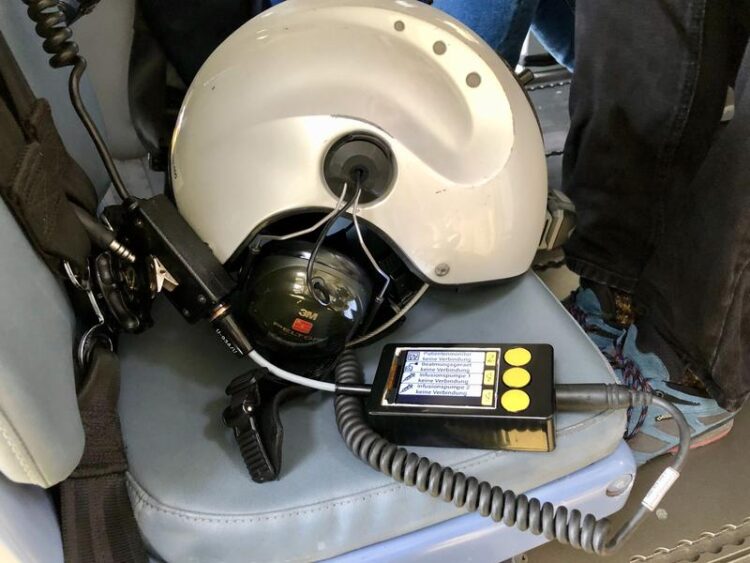Greater safety for patients in rescue helicopters

Illustration of the alarm hub prototype with connection to the intercom system and helmet
GPP Communication GmbH & Co. KG
Landshut University of Applied Sciences project develops device that transmits the medical devices’ acoustic alarm signals directly to the rescue services’ headsets
When injured people have to be rescued by rescue helicopter after an accident, every second is precious. One problem for rescue teams during such missions though is that they cannot immediately hear the medical devices’ alarm signals due to the high noise level in the helicopter and are therefore often only able to react with a time delay.
As part of the SafeAERIAL project, the project partners led by Prof Dr Guido Dietl (Landshut University of Applied Sciences) have now developed a monitoring system (“alarm hub”) that establishes wireless communication between the medical devices and the crew’s headsets, thus making the alarm functions audible without a time delay.
Landshut University of Applied Sciences worked on this with the companies GPP Communication, GS Elektromedizinische Geräte G. Stemple and YOUSE, the ADAC air rescue was involved as an associated partner. The project was funded by the Bavarian State Ministry of Economic Affairs and Media, Energy and Technology. The total project sum is approximately 700,000 euros.
Almost market-ready prototype
If a patient’s breathing or heart rate changes, the medical devices immediately issue an alarm signal. “However, in the helicopter it is so loud that the rescue team cannot hear these signals,” explains project manager Prof Dietl. The solution to the problem is an alarm management system that bundles the signals and forwards them to a third point (e.g. an intercom system).
“So far, this kind of system does not exist in rescue helicopters though,” says Dietl. He and his team have therefore been researching a solution since the beginning of 2018. The result: an almost market-ready prototype of a so-called alarm hub. The device collects the alarm signals via wireless communication interfaces and transmits them via the helicopter’s intercom interface to the rescue services’ headsets. Dietl is convinced: “This alarm hub improves both the working conditions for medical staff and the safety of patients.”
Development of an additional adapter
In addition to the alarm hub, the research team developed an energy-saving adapter for the wireless Bluetooth low-energy connection of all medical devices that do not have a wireless interface. The researchers found an intelligent solution for collecting the required energy via the communication interface, so that no further energy supply is needed. Extensive maintenance work, e.g. to replace batteries, is therefore no longer necessary. In the final step, the research team tested that the alarm hub works in the field and evaluated the results.
About the project
The “SafeAERIAL – safe alarming of electromedical devices via rescue helicopter intercom systems” project ran from 2018 to 2020. Prof Dr Guido Dietl from Landshut University of Applied Sciences was responsible for the project management. Other project partners are GPP Communication GmbH & Co, GS Elektromedizinische Geräte G. Stemple GmbH and YOUSE GmbH. The project is funded by the Bavarian State Ministry of Economic Affairs and Media, Energy and Technology. The total project sum is approximately 700,000 euros.
Media Contact
All latest news from the category: Medical Engineering
The development of medical equipment, products and technical procedures is characterized by high research and development costs in a variety of fields related to the study of human medicine.
innovations-report provides informative and stimulating reports and articles on topics ranging from imaging processes, cell and tissue techniques, optical techniques, implants, orthopedic aids, clinical and medical office equipment, dialysis systems and x-ray/radiation monitoring devices to endoscopy, ultrasound, surgical techniques, and dental materials.
Newest articles

Parallel Paths: Understanding Malaria Resistance in Chimpanzees and Humans
The closest relatives of humans adapt genetically to habitats and infections Survival of the Fittest: Genetic Adaptations Uncovered in Chimpanzees Görlitz, 10.01.2025. Chimpanzees have genetic adaptations that help them survive…

You are What You Eat—Stanford Study Links Fiber to Anti-Cancer Gene Modulation
The Fiber Gap: A Growing Concern in American Diets Fiber is well known to be an important part of a healthy diet, yet less than 10% of Americans eat the minimum recommended…

Trust Your Gut—RNA-Protein Discovery for Better Immunity
HIRI researchers uncover control mechanisms of polysaccharide utilization in Bacteroides thetaiotaomicron. Researchers at the Helmholtz Institute for RNA-based Infection Research (HIRI) and the Julius-Maximilians-Universität (JMU) in Würzburg have identified a…



